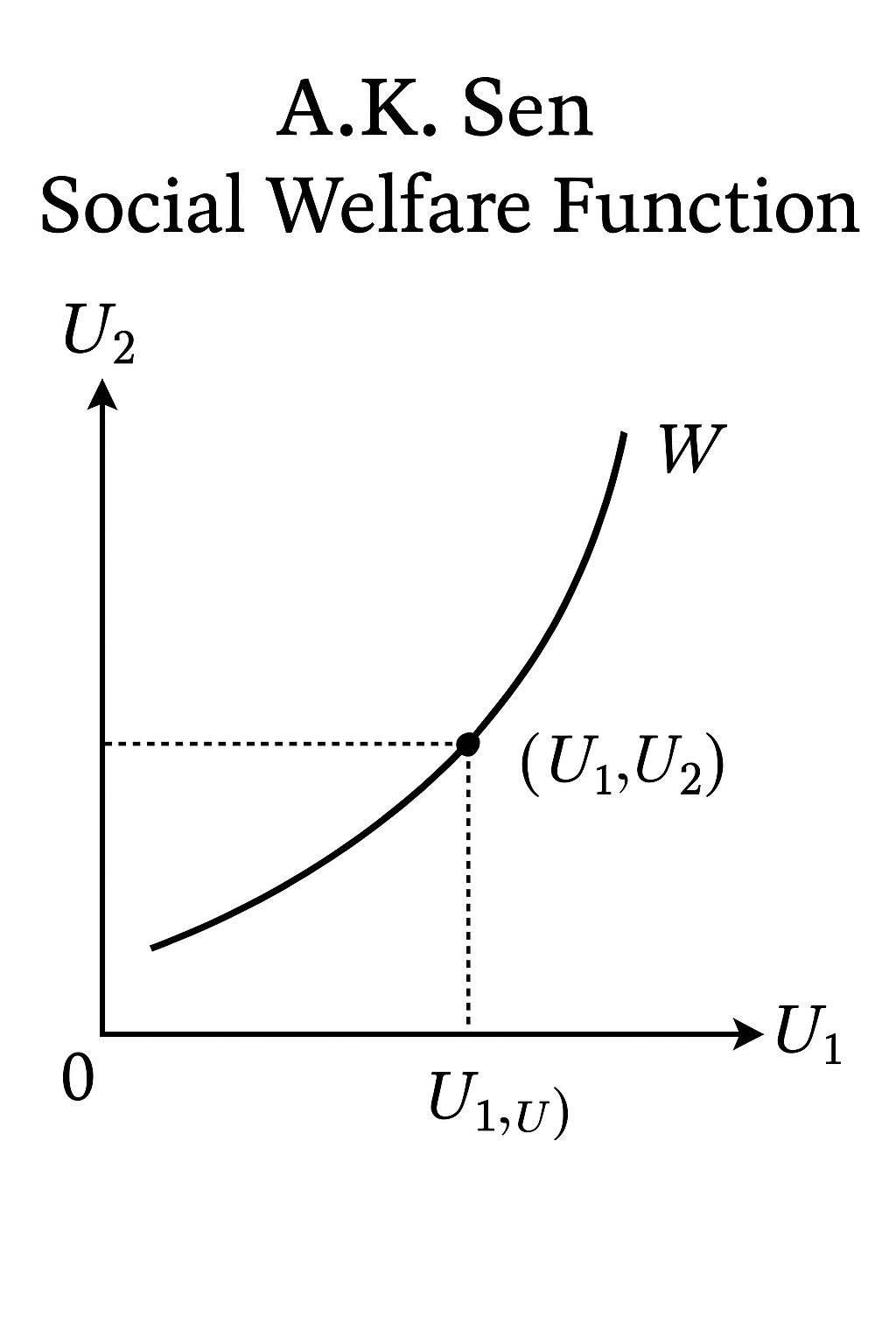
25 Jul A.K. Sens Social Welfare Function
A.K. Sen’s Social Welfare Function – UPSC Economics Optional Notes
Introduction
A.K. Sen, one of the most influential economists and philosophers of modern times, has contributed significantly to the development of welfare economics. His work on the Social Welfare Function expanded the narrow utilitarian and Paretian perspectives by integrating ethical considerations, rights, and human capabilities. Sen’s framework paved the way for a more humane and multidimensional view of economic welfare.
Sen’s ideas challenged the traditional notions of utility and efficiency and brought attention to justice, equity, and the importance of real freedoms. He received the Nobel Prize in Economics in 1998 for his work on welfare economics and social choice theory.
What is a Social Welfare Function?
A Social Welfare Function (SWF) is a mathematical representation of society’s preferences over different allocations of resources or states of the world. It is a tool to assess the overall welfare of a society based on individual utilities.
In classical welfare economics (e.g., by Bergson and Samuelson), a SWF is derived from individual utility functions. However, Sen introduced a moral and philosophical critique of this framework and proposed a broader model that incorporates equity, interpersonal comparisons, and individual capabilities.
Sen’s Critique of Traditional Welfare Functions
- Paretian Limitation: Pareto efficiency is silent on inequality. A situation where the rich are better off and the poor unchanged is still Pareto optimal.
- Arrow’s Theorem: Arrow’s Impossibility Theorem highlighted the difficulty of aggregating individual preferences into a consistent social choice. Sen attempted to move forward from Arrow’s pessimism.
- Lack of Interpersonal Comparisons: Traditional models avoided comparing utilities across people. Sen argued that without interpersonal comparisons, welfare judgments are ethically empty.
Sen’s Contributions
1. Interpersonal Comparisons of Utility
Sen advocated for meaningful interpersonal utility comparisons to incorporate fairness and justice into welfare assessments. He accepted the use of cardinal utilities instead of just ordinal preferences.
2. Capabilities Approach
This is the most revolutionary aspect of Sen’s work. He proposed that welfare should be evaluated not by utility but by the capabilities — i.e., real freedoms or opportunities — that people have to live the kind of life they value.
- Functionings: The beings and doings of a person (e.g., being nourished, being educated).
- Capabilities: The set of functionings a person can achieve — their potential to act and be.
This approach later influenced the creation of the UNDP’s Human Development Index (HDI).
3. Sen’s Liberal Paradox
In his famous 1970 paper, Sen
showed that even minimal liberal rights (like choosing your own socks) can conflict with Pareto efficiency. This paradox highlighted the tension between individual rights and collective welfare.
Mind Map
Infographic
Sen’s Social Welfare Function: Mathematical & Philosophical Elements
- Allows for distributional weights or ethical parameters.
- Includes interpersonal utility comparisons.
- Focus on equity, not just efficiency.
- Incorporates capabilities, not just outcomes.
- Operates in a rights-sensitive framework.
Criticism of Sen’s Welfare Approach
- Operational Difficulty: Capabilities are difficult to define, measure, and compare across individuals.
- Too Broad: Some argue that Sen’s framework is too philosophical and lacks clear policy prescriptions.
- Subjectivity: The approach requires subjective judgments regarding which capabilities are valuable.
Best economics optional coaching for upsc
Real-World Applications
- Influenced UNDP’s Human Development Index (HDI)
- Used in evaluating development policies
- Guided social welfare programs and poverty measurement
- Basis for feminist economics, education policies, health equity frameworks
Previous Year Questions (PYQs) from UPSC CSE Economics Optional
- UPSC 2023: Explain the core features of Amartya Sen’s Social Welfare Function and how it improves upon the utilitarian model.
- UPSC 2020: What is the capabilities approach of A.K. Sen? How is it different from traditional utility-based approaches?
- UPSC 2017: Discuss Sen’s Liberal Paradox and its implications for welfare economics.
Probable Questions for UPSC (Prelims & Mains)
- Mains: Discuss the implications of A.K. Sen’s welfare function in modern policy-making and poverty alleviation.
- Mains: Explain how A.K. Sen’s work goes beyond Arrow’s Impossibility Theorem in Social Choice Theory.
- Prelims: Which of the following is NOT associated with Amartya Sen’s capabilities approach?a) Functionings
b) Preferences
c) Freedom
d) OpportunityAnswer: b) Preferences
Conclusion
A.K. Sen’s Social Welfare Function revolutionized the field of welfare economics by humanizing it. Instead of focusing solely on abstract utility maximization, Sen emphasized real freedoms, justice, and human dignity. His contributions remain vital for policymakers, economists, and UPSC aspirants alike.
Understanding Sen’s model not only strengthens your grasp on economics but also enhances your answers in General Studies, Essay paper, and Ethics case studies in the UPSC exam.






No Comments